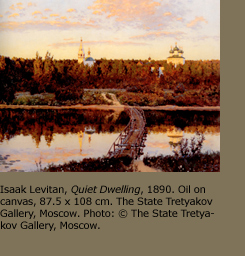|

Watch the RUSSIA! promotional spot which appears on Thirteen/WNET.
QuickTime version
Windows Media version
You can play the promotional spot through your browser provided the plug-ins are installed.
Download QuickTime
Download Windows Media
The Slavic and Baltic Division of The New York Public Library
The Slavic and Baltic Division of The New York Public Library is one of North America's most significant collections for the study of art and architecture of East Slavic cultures. Materials range from 14th century illuminated manuscripts to the latest in art historical research from the countries of Eastern Europe and the Baltics.
For further information, vist The Slavic and Baltic Division of the New York Public Library or contact Robert Davis at 212.930.0940.
The Library of Congress
The Library of Congress, the world's largest library and the national library of the United States, maintains comprehensive collections of materials from and about Russia. Materials on Russian art are well represented in the Library's collections and include the major published scholarly, critical and historical works, as well as published reproductions of works of Russian artists. In addition, the Library has a number of unique special collections related to the arts of Russia, chief among them the Prokudin-Gorsky collection, a series of 1,900 pioneering color photographs taken 1905-1915 in the Russian and Central Asian countryside. Visit the Library's website to read a description of its Russian collections as well as to access its online catalog.
|
|

RUSSIA! is the most comprehensive and significant exhibition of Russian art
outside Russia since the end of the Cold War. Including more than 250
artworks, many of which have rarely or never traveled abroad, this
innovative presentation features the greatest masterpieces of Russian art
from the 13th century to the present, as well as a selection of first-class
Western European paintings and sculptures from the imperial art collections
assembled by Peter the Great, Catherine the Great, and Nicholas I in the
18th and 19th centuries, and later in the early 20th century by the Moscow
merchants Sergei Shchukin and Ivan Morozov.
The exhibition unfolds chronologically and fills the Guggenheim rotunda and
galleries, beginning in the High Gallery and concluding in Annex Level 7.
The first section is devoted to the age of the icon from the 13th through
the 17th centuries. While initially the visual culture of the Russian
Orthodox Church followed the model developed in Byzantium, by the 15th
century a distinctly Russian Orthodox art emerged. The iconostasis, a wall
of painted images, visually dominates Eastern Orthodox churches. By the 16th
century, the Russian Orthodox Church had developed a five-tiered screen that
incorporated not only the traditional triptych of Christ, the Virgin, and
St. John the Baptist (known as the Deesis), but also tiers for the
Patriarch, Prophets, Holy Days, and Worship.
This exhibition includes multiple panels of the Deesis tier from the famous
1497 iconostasis of the Kirillo-Belozersk Monastery's Dormition Cathedral.
This impressive set of five near-life-sized panels from the Deesis tier and
three icons from the Festive or Holy Days tier, along with select textiles
depicting St. Kirill (1327–1427), provide a glimpse into the remarkable
visual culture of Russia in the 15th century.
The second section, located in Annex Level 2, is devoted to the royal art
collections of the 18th and early 19th centuries. In his travels abroad,
Peter the Great (1672–1725; reign 1682–1725) developed an interest in art,
and one of his most outstanding acquisitions is shown here, the Italian
artist Garofalo's The Entombment of 1520. His granddaughter-in-law Catherine
the Great (1729–1796; reign 1762–96) assembled a first-rate collection of
Western paintings from largely English and French collections, which became
the basis of her Hermitage. Nicholas I (1796–1855; reign 1825–55) founded
the Imperial Hermitage Museum as a public museum in 1852 and added Italian,
Dutch, and Spanish works to the Hermitage's holdings.
[MORE]
ON SPLASH PAGE: Ivan Kramskoy, Unknown Woman, 1883. Oil on canvas, 75.6 x 99.1 cm. The State Tretyakov Gallery, Moscow. Photo: © The State Tretyakov Gallery, Moscow.
|